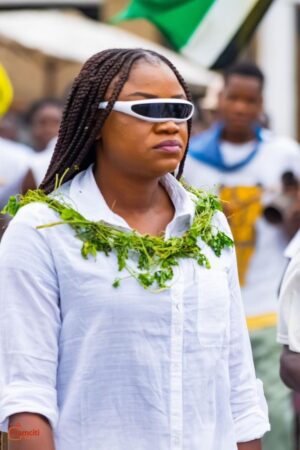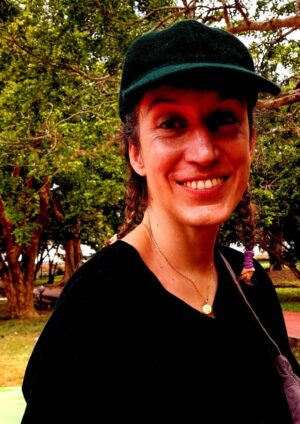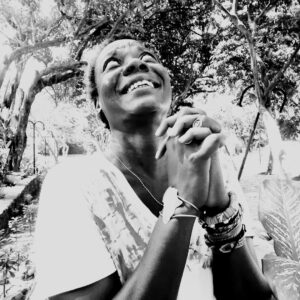The famous Shika Shika Art fair was a major part of the ChaleWote Street Arts Festival portfolio is part of this year’s activities, which opened on Monday.
This year’s fair will be showing the historical and contemporary works of artists from across Africa and the Black diaspora. The Shika Shika Art fair is a street art fair at CHALE WOTE which began in 2017,and will be featuring a psychedelic mix of work across different generations and disciplines.
In a related development, the artists below are part of array of artists whose works are on display at the festival.
ChaleWote Streets Art festival #meetyourartists
Sessi Milia and Nora Le Jean
Are a performance duo, both professionally and as a family, hailing from Benin and France, respectively. Sessi Milia, a spiritual visual artist and musician-composer, and Nora Le Jean, a visual artist, symbolist, and socio-anthropologist, are co-founders of Espace Essence-Ciel in Benin.

Sessi and Nora believe that all life forms, visible and invisible, are bound by a common energy that animates everything. This energy links the mineral, plant, animal, and human kingdoms with the elements of fire, water, earth, and air, driving humanity forward on its evolutionary path. Their work seeks to highlight this interconnectedness, offering a creative vision that emphasizes harmony and the shared energy that unites all life.
Together, they will be creating an immersive performance that blends visual art with interactive experiences centered around Adinkra symbols. Their work explores the profound connections between various life forms on Earth, driven by the question: What connects us as human beings? Through their performances, they invite spectators into a space where different forms of life are sublimated, revealing the potential creators within us all, both sensitively and emotionally.
Their artistic practice aims to foster a deeper understanding of our interconnectedness and to contribute to the enduring spirit of a nation that embraced its narrative and future. An end to the empire of horrors #chalewote2024
And Now An End To The Empire Of Horrors. #meetyourartists
Charity Derby AkeitiCharity Derby Akeiti is a multifaceted artist and advocate, working as a colour consultant, art journalist, painter, sculptor, and graphic and textile designer. Throughout her career, she has focused on issues affecting women in West African society, using her unique perspective and artistic talents to highlight the stories of women in her community across various mediums. Akeiti’s commitment to using art for social change has earned her respect in the art world and among advocacy circles.

For the Chalewote Street Art Festival 2024, Akeiti will present a piece that reimagines the contemporary perceptions and concepts surrounding the Battle of Guinea in 1478, a pivotal event that paved the way for a brutal colonial conquest, often referred to as the “empire of horrors.” This conquest devastated some of the remaining Indigenous civilisations along the Guinea coast.
Akeiti will work on a large festival canvas, using acrylic on bleached yellow fabric to create a visually striking piece. Her use of vibrant colours and intricate details will capture the complexity of this historical event. Through this work, Akeiti aims to provoke thought and inspire dialogue about the impact of oppressive regimes on Indigenous cultures, bringing attention to often overlooked narratives in history. Her art seeks to challenge viewers to reflect on these difficult topics, making space for important conversations about the legacies of colonialism and the resilience of Indigenous peoples. #chalewote2024
Meet the Artists #chalewote24

Vanessa Gerotto’s work aims to highlight the beauty, strength, and fragility of the earth and all its living forms in spite of the butchery it has undergone. The gigantic painting draws from the knowledge system of the Ewe Dzesiwo. The Ewe Dzesiwo are proverbial symbols originating from the Ewe people of Ghana. And Now An End To The Empire Of Horrors, August 19th-25th
Afifa Aza
Afifa Aza, an alumna of the University of the West Indies, Mona, in Jamaica, conceptualised her project Time Machine three years ago while working on a project about memory.
Drawing inspiration from the creative music studio environment of Lee Scratch Perry and the Jamaican Sound System Culture, Afifa decided to create the Time Machine as a sound system. This system would be designed using speakers and electronic equipment that she crafted herself, blending elements of sculpture with technology.
She incorporated wood, recycled computer parts, and old electronics to construct a system that not only serves as a listening device but also symbolises the presence of our ancestors, who form its foundation.

The Time Machine experiments with creating a distinctive listening environment, offering the public a space where they can connect, remember, and dream. Powered by a selection of music from Africa and the Diaspora, the Time Machine becomes a vessel through which history, memory, and culture intertwine, inviting listeners on a journey through time.
Nana Yaw Ananse
In his artistic practice, he transforms discarded materials collected from the beaches of Accra, Ghana-such as rubber bags, plastic bottles, second-hand clothes, and Neem tree bark—into evocative artworks that explore the deep legacies of colonialism in West Africa. The historical backdrop of his work is the Battle of Guinea in 1478, a crucial conflict that marked the beginning of European colonial dominance in the region. This event serves as a lens through which he examines the enduring impacts of colonialism on the land, people, and
ecosystems of West Africa. By using materials sourced from Ghana’s shorelines, which reflect the ongoing environmental and social repercussions of global trade and consumption, he aims to draw connections between the past and present. His art invites viewers to reflect on the lasting reverberations of colonial histories and to consider the complexities of cultural exchange, exploitation, and resilience.

The inclusion of Neem tree bark in his work symbolises the mythical tales of giants— godlike beings who once walked the earth and imparted knowledge to humanity. These giant stories, echoing along the coast of Guinea, inspire a dialogue between past and present, myth and reality.
Through this blending of mythical narratives with contemporary environmental concerns, he seeks to highlight the intersections of storytelling, cultural memory, and ecological sustainability. His work serves as a visual dialogue, encouraging contemplation of the intertwined histories and narratives that shape our world.
By repurposing these materials into art, he honour the resilience and creativity of Ghanaian communities while raising critical questions about our collective responsibilities towards the environment and those affected by globalisation and exploitation. Through the transformative power of art, he strives to invoke a sense of wonder and curiosity that transcends time and space.










